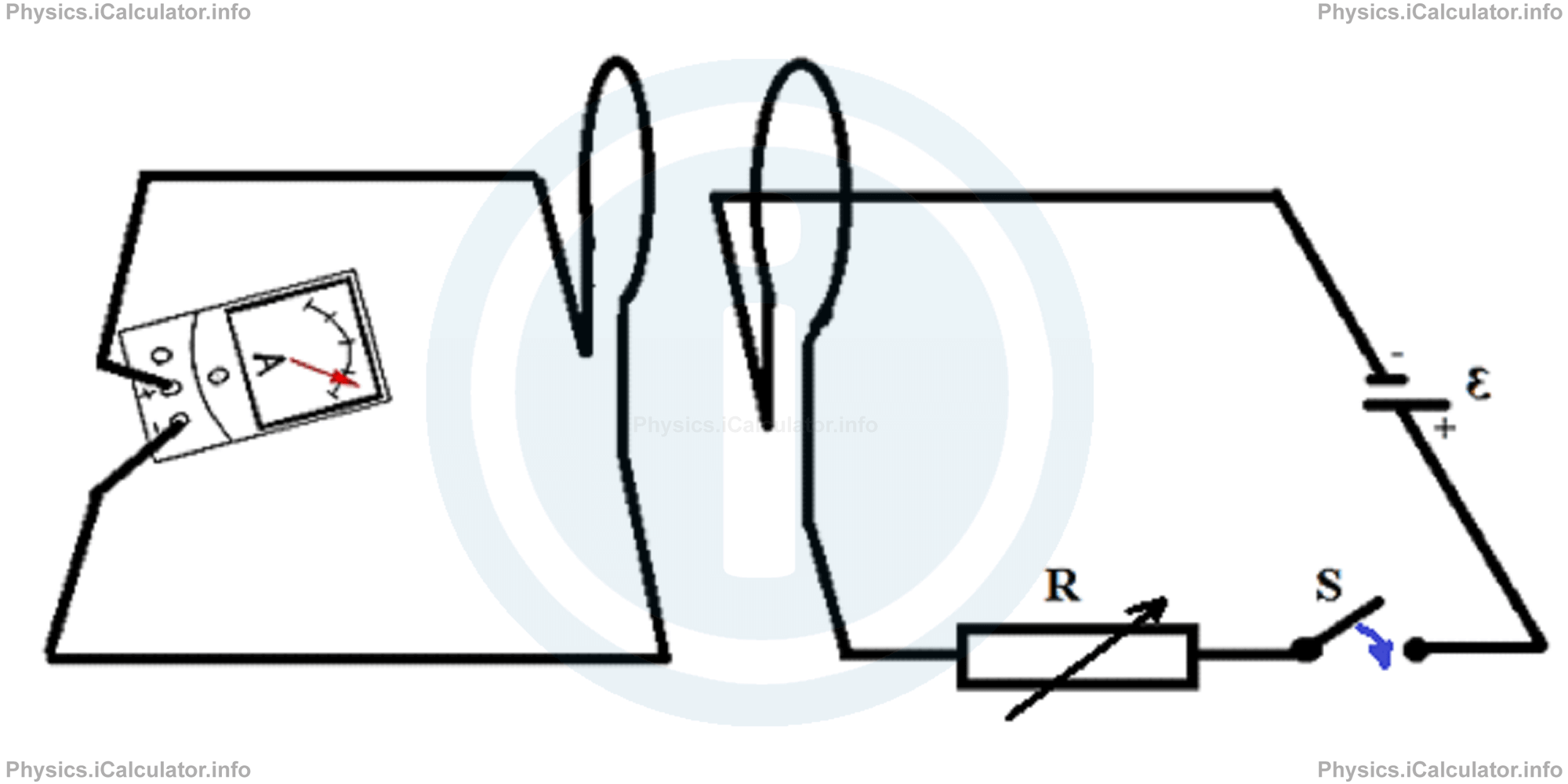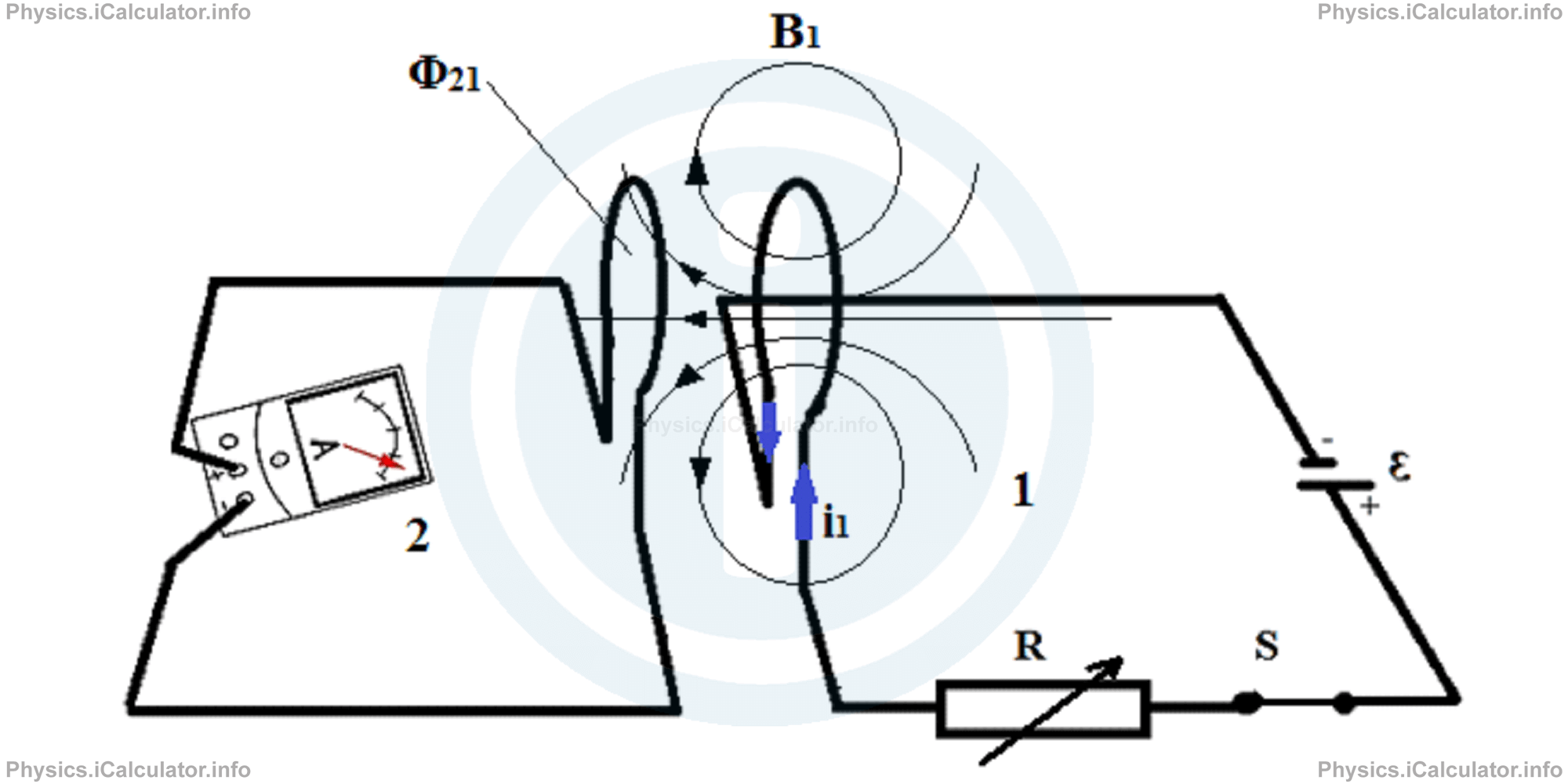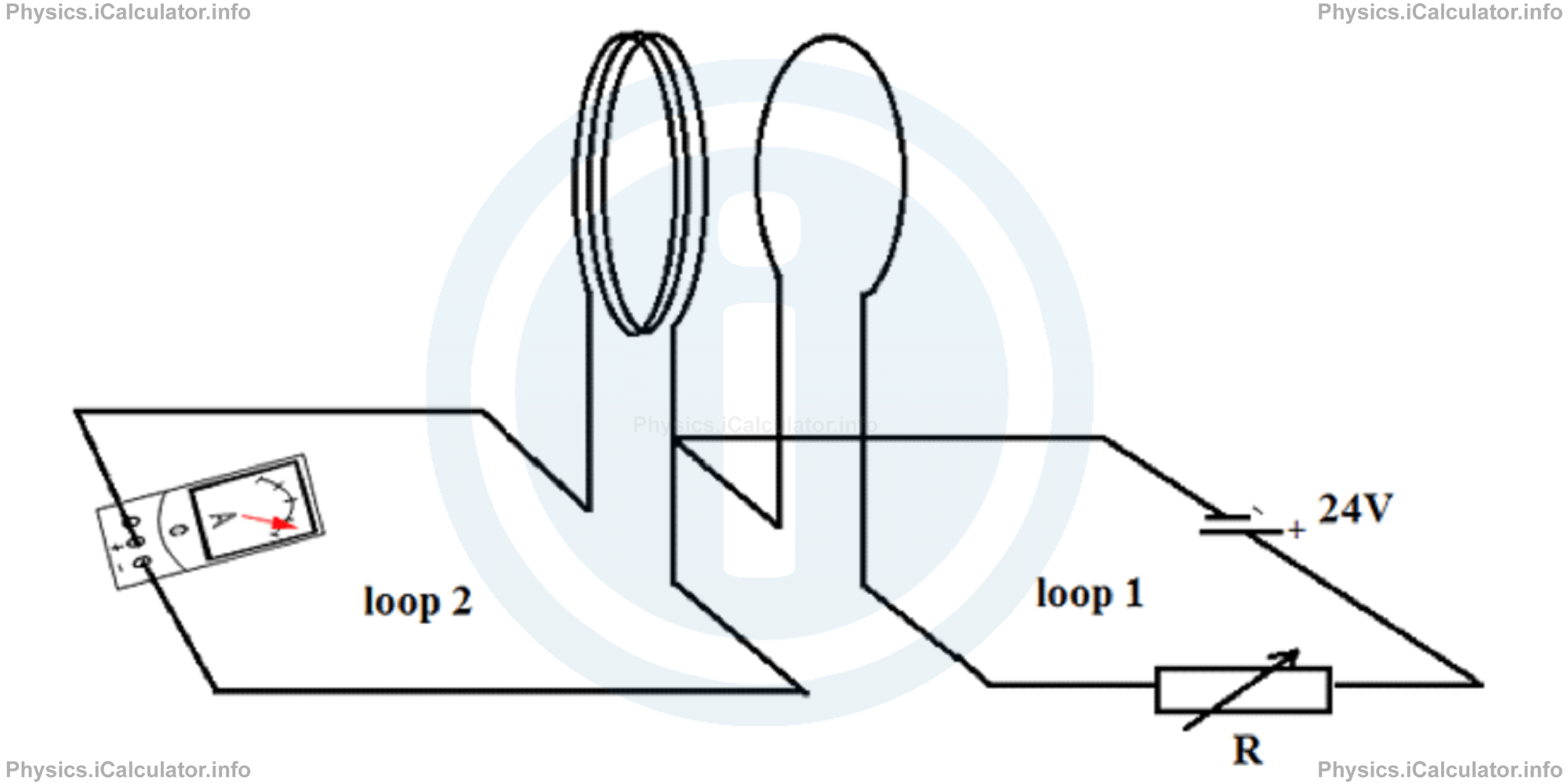Menu
Physics Lesson 16.13.3 - Mutual Induction
Please provide a rating, it takes seconds and helps us to keep this resource free for all to use
Welcome to our Physics lesson on Mutual Induction, this is the third lesson of our suite of physics lessons covering the topic of Energy Stored in a Magnetic Field. Energy Density of a Magnetic Field. Mutual Induction, you can find links to the other lessons within this tutorial and access additional physics learning resources below this lesson.
Mutual Induction
Let's recall the experiment explained in the tutorial 16.7 in which two loops are near each other and a current is induced in one of the loops when turning the switch ON or OFF in the circuit containing the other loop. In addition, the arrow symbol in the resistor means it is a rheostat (variable resistor). As such, the value of current in the circuit can changed not only by turning the switch ON or OFF but also by changing the values of resistance in the rheostat. In this way, we can change the magnitude not only of the induced current but of the corresponding magnetic field as well.

The process of producing a current through a variable magnetic field is called induction, as explained in precedent tutorials. The induction by which electric current is produced in one coil by changing the magnetic field of the other coil requires the presence of two coils. If one coil is moved away, no current is induced in the other coil due to the long distance. Therefore, the current (and the resulting magnetic field) in one coil produced by this mutual interaction is known as mutual induction.
The mutual induction differs from the self-induction of an inductor, as in the case of inductor the presence of a single solenoid is enough to induce a magnetic field inside it.
When the variable resistor in the figure above is set in a fixed position R, the source produces a steady current I in the circuit. As a result, a magnetic field (and flux) are produced in the coil on the left.

The mutual inductance of the coil 2 (due right) on the coil 1 (due left) is denoted by m21. It is calculated by
In our figure we have N1 = N2 = 1 as both coils have one turn only, but if there are kore turns, we must write their number accordingly.
The above equation has the same form as the equation of inductance for a single coil
explained in the tutorial 16.9.
We can write the equation (2) as
If we slightly change the value of resistance R, we obtain a variation of current, so we can write
From the Faraday's Law, the right side of the above equation represents the emf induced in the coil 2 due to the change in current in the coil 1. Since it opposes the current I1, we obtain
This reasoning can be used for the emf induced in the first coil as well (due to the law of conservation of energy). Therefore, we can write
Experiments show that m12 = m21. Thus, we can write the mutual inductance simply by M. in this way, the two above equations become
and
Example 3
A single loop is connected to a 24V battery and a rheostat. The position of rheostat shifts from 20Ω to 8Ω in 2 seconds. This brings an induced current in the second coil, which contains 400 turns. Each coil has an area of 12 cm2. Calculate:
- The mutual inductance if the induced emf in the second coil at the end of process is 120V
- The value shown by the ammeter at the end of process
- The change of magnetic flux in the second coil
- The change in the induced magnetic field in the second coil

Solution 3
Clues:
ε1 = 24 V
Ri = 20 Ω
Rf = 8 Ω
dt = 2 s
A1 = A2 = A = 12 cm2 = 0.0012 m2
B1 = 400 mT = 0.4 T
N1 = 1
N2 = 400
ε2 = 200 V
a) M = ?
b) i2 = ?
c) ΔΦ2 = ?
d) ΔB2 = ?
- First, we calculate the change in current in the first coil due to the change in resistance. We have i1(initial) = ε/R1and
= 24 V/20 Ω
= 1.2 Ai1(final) = ε/R2Thus,
= 24 V/8 Ω
= 3 Adi1 = i1(final) - i1(initial)From theory, we know that
= 3 A - 1.2 A
= 1.8 Aε2 = -M ∙ di1/dtIgnoring the negative sign and substituting the values, we obtain for the mutual inductance:M = ε2 ∙ dt/di1
= (200 V) ∙ (2 s)/(1.8 A)
= 222 H - We use the equationε1 = -M ∙ di2/dtto calculate the value shown by the ammeter (which is the value of i2, i.e. the value of current induced in the second coil), where M is the mutual inductance found at (a). Thus, ignoring again the negative sign, we obtaindi2 = ε1 ∙ dt/M
= (24 V) ∙ (2 s)/(222 H)
= 0.216 A - Giving that ε2 = -N2 ∙ dΦ21/dtwe obtain for the change in the magnetic flux in the second coil (the magnitude only):dΦ21 = ε2 ∙ dt/N2
= (200 V) ∙ (2 s)/400
= 1 Wb - Since for a fixed area of loop any change in magnetic flux is due to the change in the magnetic field, we have ∆Φ21 = ∆B2 ∙ A
∆B2 = ∆Φ21/A
= 1 Wb/0.0012 m2
= 833.3 T
You have reached the end of Physics lesson 16.13.3 Mutual Induction. There are 3 lessons in this physics tutorial covering Energy Stored in a Magnetic Field. Energy Density of a Magnetic Field. Mutual Induction, you can access all the lessons from this tutorial below.
More Energy Stored in a Magnetic Field. Energy Density of a Magnetic Field. Mutual Induction Lessons and Learning Resources
Whats next?
Enjoy the "Mutual Induction" physics lesson? People who liked the "Energy Stored in a Magnetic Field. Energy Density of a Magnetic Field. Mutual Induction lesson found the following resources useful:
- Mutual Induction Feedback. Helps other - Leave a rating for this mutual induction (see below)
- Magnetism Physics tutorial: Energy Stored in a Magnetic Field. Energy Density of a Magnetic Field. Mutual Induction. Read the Energy Stored in a Magnetic Field. Energy Density of a Magnetic Field. Mutual Induction physics tutorial and build your physics knowledge of Magnetism
- Magnetism Revision Notes: Energy Stored in a Magnetic Field. Energy Density of a Magnetic Field. Mutual Induction. Print the notes so you can revise the key points covered in the physics tutorial for Energy Stored in a Magnetic Field. Energy Density of a Magnetic Field. Mutual Induction
- Magnetism Practice Questions: Energy Stored in a Magnetic Field. Energy Density of a Magnetic Field. Mutual Induction. Test and improve your knowledge of Energy Stored in a Magnetic Field. Energy Density of a Magnetic Field. Mutual Induction with example questins and answers
- Check your calculations for Magnetism questions with our excellent Magnetism calculators which contain full equations and calculations clearly displayed line by line. See the Magnetism Calculators by iCalculator™ below.
- Continuing learning magnetism - read our next physics tutorial: Alternating Current. LC Circuits
Help others Learning Physics just like you
Please provide a rating, it takes seconds and helps us to keep this resource free for all to use
We hope you found this Physics lesson "Energy Stored in a Magnetic Field. Energy Density of a Magnetic Field. Mutual Induction" useful. If you did it would be great if you could spare the time to rate this physics lesson (simply click on the number of stars that match your assessment of this physics learning aide) and/or share on social media, this helps us identify popular tutorials and calculators and expand our free learning resources to support our users around the world have free access to expand their knowledge of physics and other disciplines.
Magnetism Calculators by iCalculator™
- Angular Frequency Of Oscillations In Rlc Circuit Calculator
- Calculating Magnetic Field Using The Amperes Law
- Capacitive Reactance Calculator
- Current In A Rl Circuit Calculator
- Displacement Current Calculator
- Electric Charge Stored In The Capacitor Of A Rlc Circuit In Damped Oscillations Calculator
- Electric Power In A Ac Circuit Calculator
- Energy Decay As A Function Of Time In Damped Oscillations Calculator
- Energy Density Of Magnetic Field Calculator
- Energy In A Lc Circuit Calculator
- Faradays Law Calculator
- Frequency Of Oscillations In A Lc Circuit Calculator
- Impedance Calculator
- Induced Emf As A Motional Emf Calculator
- Inductive Reactance Calculator
- Lorentz Force Calculator
- Magnetic Dipole Moment Calculator
- Magnetic Field At Centre Of A Current Carrying Loop Calculator
- Magnetic Field In Terms Of Electric Field Change Calculator
- Magnetic Field Inside A Long Stretched Current Carrying Wire Calculator
- Magnetic Field Inside A Solenoid Calculator
- Magnetic Field Inside A Toroid Calculator
- Magnetic Field Produced Around A Long Current Carrying Wire
- Magnetic Flux Calculator
- Magnetic Force Acting On A Moving Charge Inside A Uniform Magnetic Field Calculator
- Magnetic Force Between Two Parallel Current Carrying Wires Calculator
- Magnetic Potential Energy Stored In An Inductor Calculator
- Output Current In A Transformer Calculator
- Phase Constant In A Rlc Circuit Calculator
- Power Factor In A Rlc Circuit Calculator
- Power Induced On A Metal Bar Moving Inside A Magnetic Field Due To An Applied Force Calculator
- Radius Of Trajectory And Period Of A Charge Moving Inside A Uniform Magnetic Field Calculator
- Self Induced Emf Calculator
- Self Inductance Calculator
- Torque Produced By A Rectangular Coil Inside A Uniform Magnetic Field Calculator
- Work Done On A Magnetic Dipole Calculator